Strategic Analysis: Telstra Networks and IT Businesses - GSBS6060
VerifiedAdded on 2021/08/23
|41
|9657
|19
Report
AI Summary
This report provides a strategic analysis of Telstra's telecommunications network infrastructure and IT businesses. It begins with an executive summary and table of contents, followed by an introduction that outlines the report's objectives. The analysis includes an examination of the external environment using PESTEL, Porter's Five Forces, and the external turbulence model to identify key political, economic, technological, legal, and environmental factors impacting Telstra. An internal analysis assesses Telstra's core competencies, strategic competitive advantages, and weaknesses. The report then explores Telstra's strategic directions, including its vision, mission, and strategic objectives, along with an ethics matrix and stakeholder analysis. It examines Telstra's business-level and international strategies, applying Ansoff's Matrix, Miles and Snow's adaptive strategies, and Porter's competitive strategies. The report assesses strategic implementation issues, evaluates Telstra's performance using the Triple Bottom Line, and concludes with recommendations for future prospects. The report highlights Telstra's alignment with its environment, organizational improvements, and technological adoption to improve successful implementation.
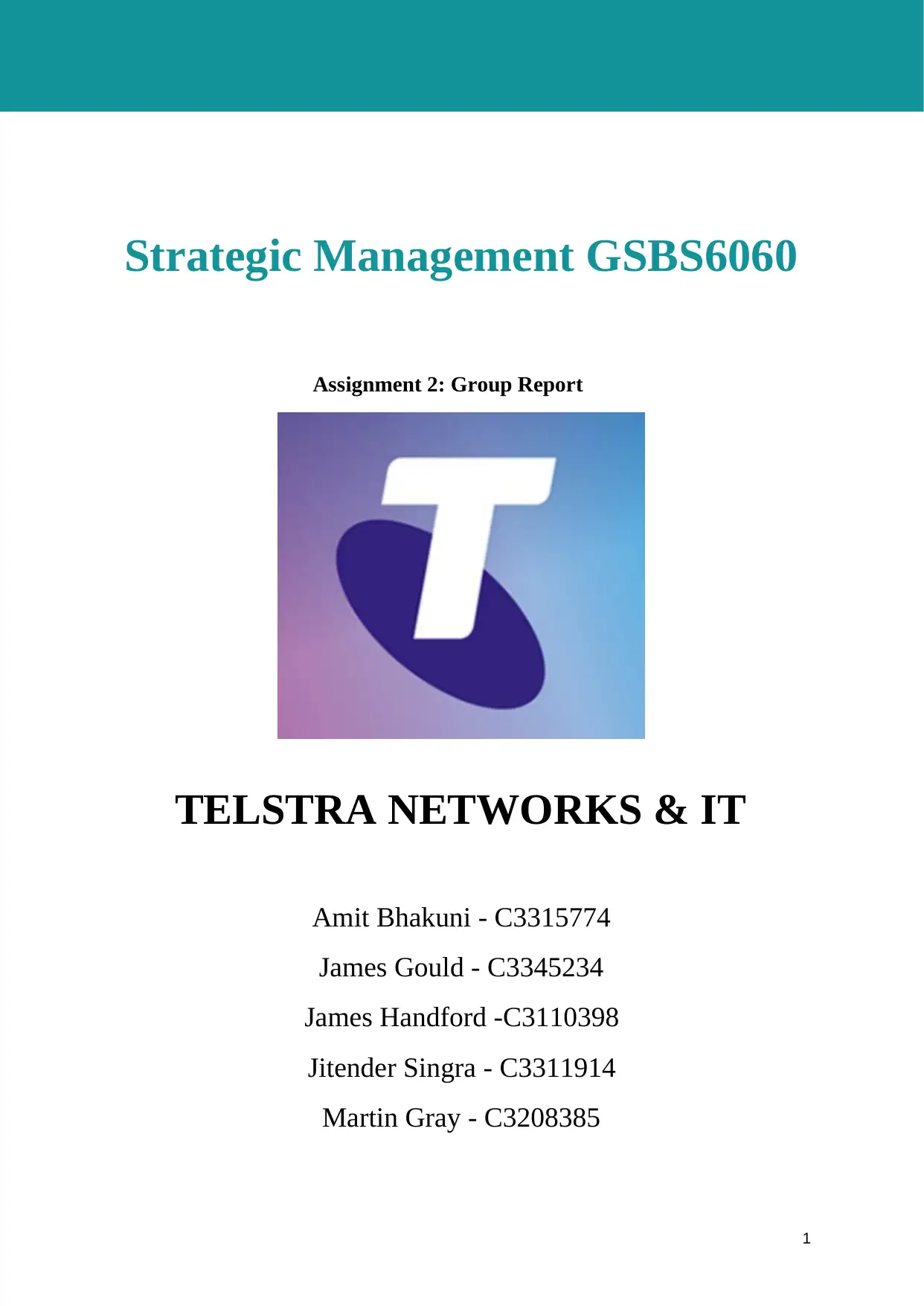
Strategic Management GSBS6060
Assignment 2: Group Report
TELSTRA NETWORKS & IT
Amit Bhakuni - C3315774
James Gould - C3345234
James Handford -C3110398
Jitender Singra - C3311914
Martin Gray - C3208385
1
Assignment 2: Group Report
TELSTRA NETWORKS & IT
Amit Bhakuni - C3315774
James Gould - C3345234
James Handford -C3110398
Jitender Singra - C3311914
Martin Gray - C3208385
1
Paraphrase This Document
Need a fresh take? Get an instant paraphrase of this document with our AI Paraphraser
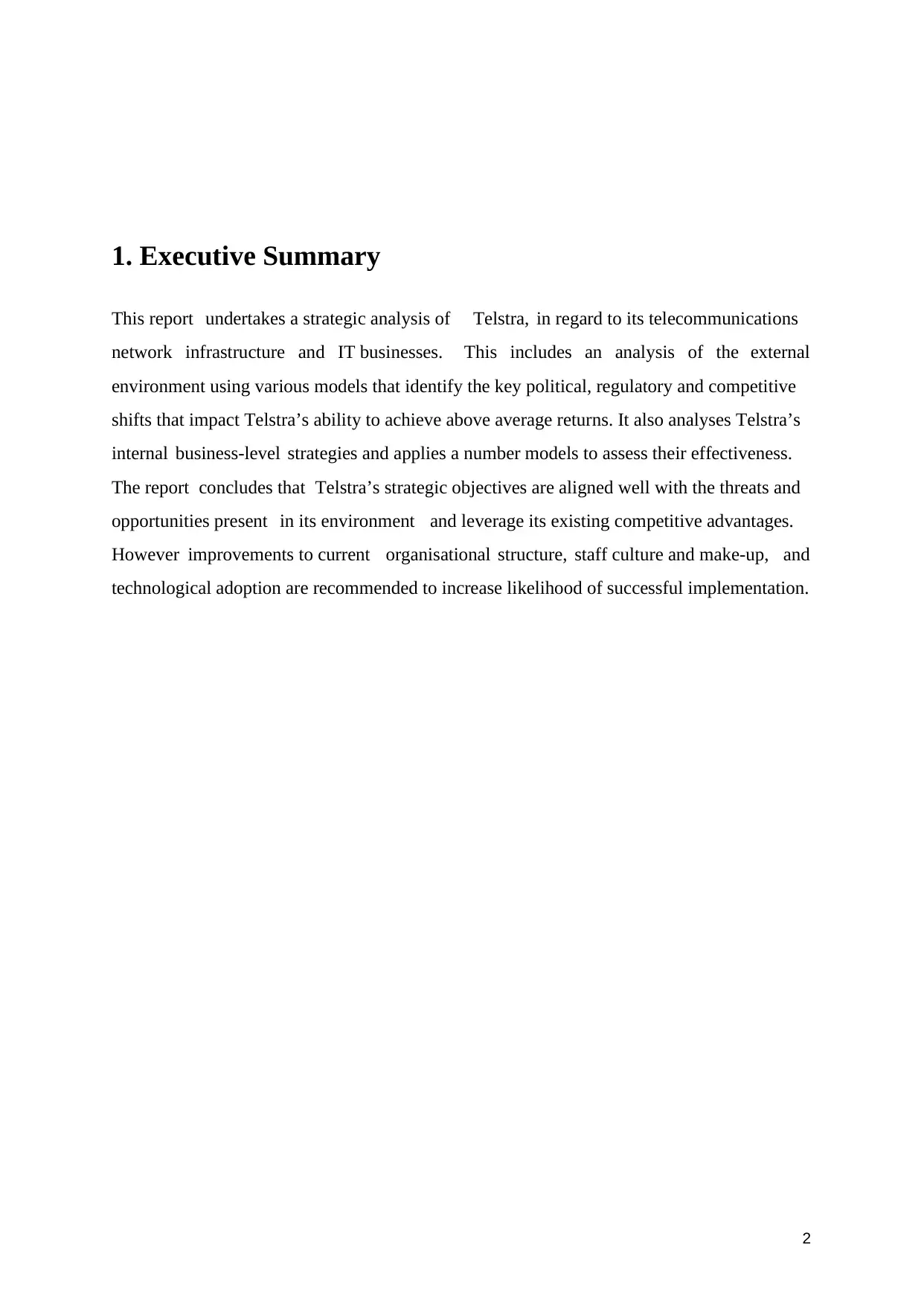
1. Executive Summary
This report undertakes a strategic analysis of Telstra, in regard to its telecommunications
network infrastructure and IT businesses. This includes an analysis of the external
environment using various models that identify the key political, regulatory and competitive
shifts that impact Telstra’s ability to achieve above average returns. It also analyses Telstra’s
internal business-level strategies and applies a number models to assess their effectiveness.
The report concludes that Telstra’s strategic objectives are aligned well with the threats and
opportunities present in its environment and leverage its existing competitive advantages.
However improvements to current organisational structure, staff culture and make-up, and
technological adoption are recommended to increase likelihood of successful implementation.
2
This report undertakes a strategic analysis of Telstra, in regard to its telecommunications
network infrastructure and IT businesses. This includes an analysis of the external
environment using various models that identify the key political, regulatory and competitive
shifts that impact Telstra’s ability to achieve above average returns. It also analyses Telstra’s
internal business-level strategies and applies a number models to assess their effectiveness.
The report concludes that Telstra’s strategic objectives are aligned well with the threats and
opportunities present in its environment and leverage its existing competitive advantages.
However improvements to current organisational structure, staff culture and make-up, and
technological adoption are recommended to increase likelihood of successful implementation.
2
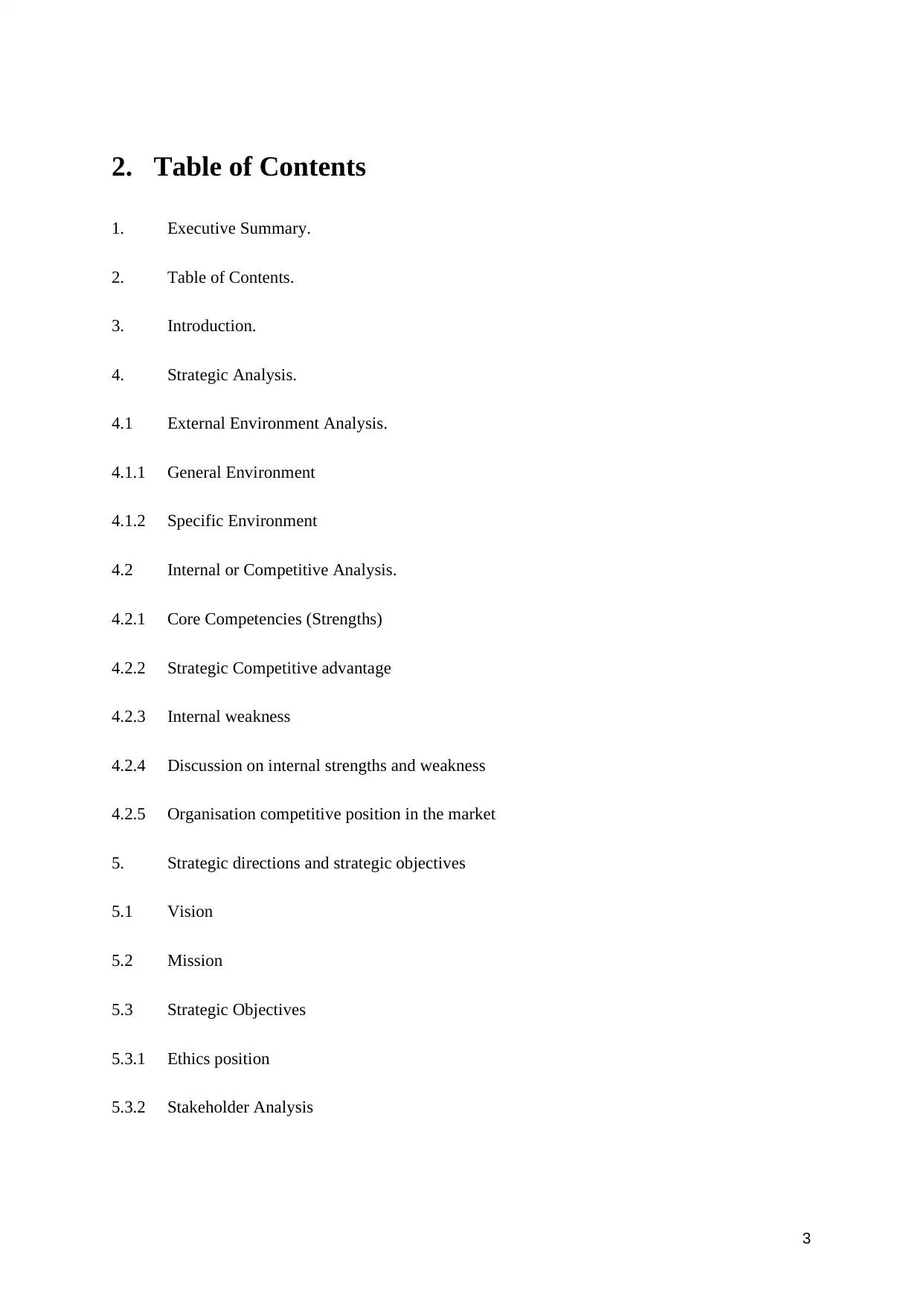
2. Table of Contents
1. Executive Summary.
2. Table of Contents.
3. Introduction.
4. Strategic Analysis.
4.1 External Environment Analysis.
4.1.1 General Environment
4.1.2 Specific Environment
4.2 Internal or Competitive Analysis.
4.2.1 Core Competencies (Strengths)
4.2.2 Strategic Competitive advantage
4.2.3 Internal weakness
4.2.4 Discussion on internal strengths and weakness
4.2.5 Organisation competitive position in the market
5. Strategic directions and strategic objectives
5.1 Vision
5.2 Mission
5.3 Strategic Objectives
5.3.1 Ethics position
5.3.2 Stakeholder Analysis
3
1. Executive Summary.
2. Table of Contents.
3. Introduction.
4. Strategic Analysis.
4.1 External Environment Analysis.
4.1.1 General Environment
4.1.2 Specific Environment
4.2 Internal or Competitive Analysis.
4.2.1 Core Competencies (Strengths)
4.2.2 Strategic Competitive advantage
4.2.3 Internal weakness
4.2.4 Discussion on internal strengths and weakness
4.2.5 Organisation competitive position in the market
5. Strategic directions and strategic objectives
5.1 Vision
5.2 Mission
5.3 Strategic Objectives
5.3.1 Ethics position
5.3.2 Stakeholder Analysis
3
⊘ This is a preview!⊘
Do you want full access?
Subscribe today to unlock all pages.

Trusted by 1+ million students worldwide
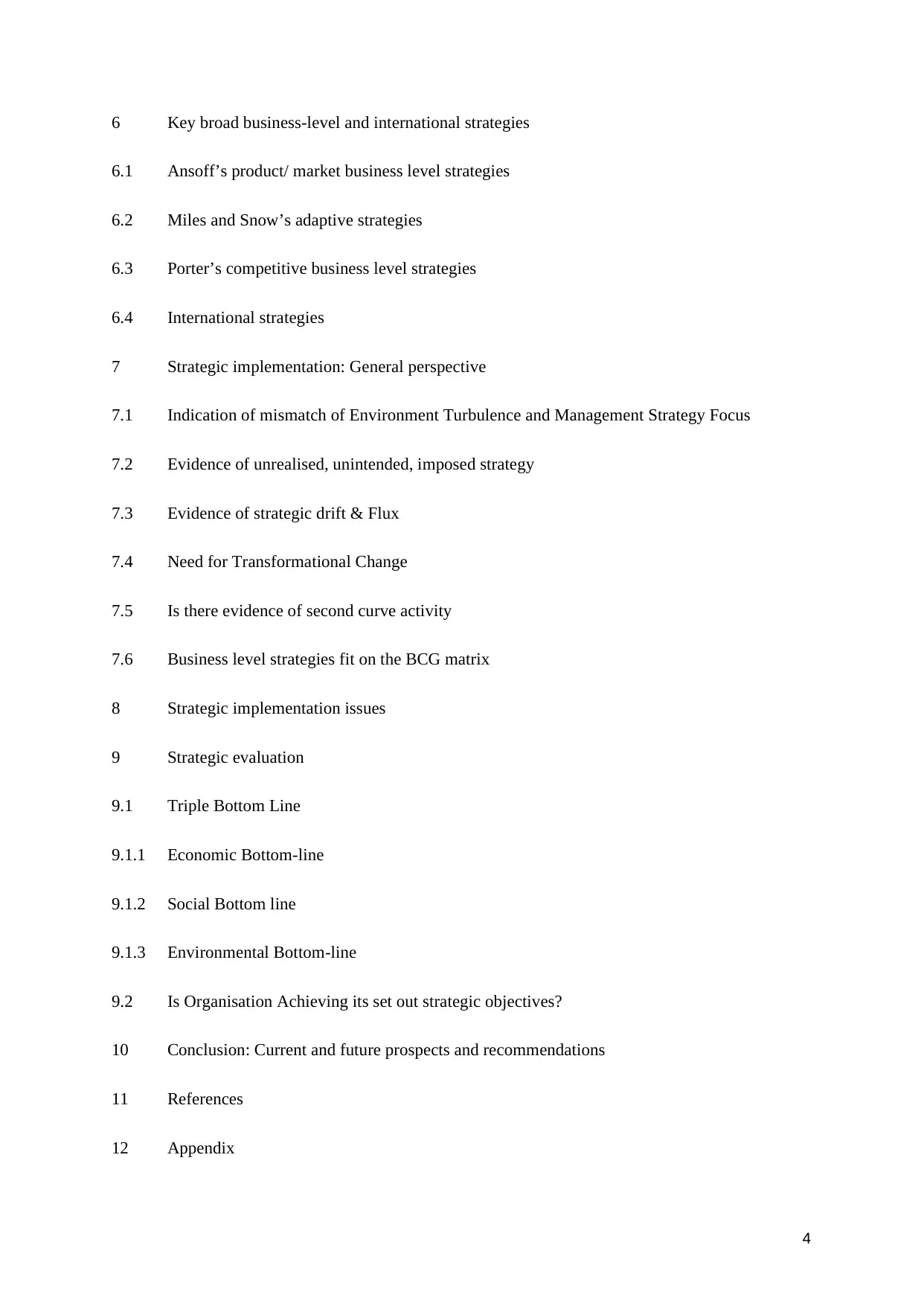
6 Key broad business-level and international strategies
6.1 Ansoff’s product/ market business level strategies
6.2 Miles and Snow’s adaptive strategies
6.3 Porter’s competitive business level strategies
6.4 International strategies
7 Strategic implementation: General perspective
7.1 Indication of mismatch of Environment Turbulence and Management Strategy Focus
7.2 Evidence of unrealised, unintended, imposed strategy
7.3 Evidence of strategic drift & Flux
7.4 Need for Transformational Change
7.5 Is there evidence of second curve activity
7.6 Business level strategies fit on the BCG matrix
8 Strategic implementation issues
9 Strategic evaluation
9.1 Triple Bottom Line
9.1.1 Economic Bottom-line
9.1.2 Social Bottom line
9.1.3 Environmental Bottom-line
9.2 Is Organisation Achieving its set out strategic objectives?
10 Conclusion: Current and future prospects and recommendations
11 References
12 Appendix
4
6.1 Ansoff’s product/ market business level strategies
6.2 Miles and Snow’s adaptive strategies
6.3 Porter’s competitive business level strategies
6.4 International strategies
7 Strategic implementation: General perspective
7.1 Indication of mismatch of Environment Turbulence and Management Strategy Focus
7.2 Evidence of unrealised, unintended, imposed strategy
7.3 Evidence of strategic drift & Flux
7.4 Need for Transformational Change
7.5 Is there evidence of second curve activity
7.6 Business level strategies fit on the BCG matrix
8 Strategic implementation issues
9 Strategic evaluation
9.1 Triple Bottom Line
9.1.1 Economic Bottom-line
9.1.2 Social Bottom line
9.1.3 Environmental Bottom-line
9.2 Is Organisation Achieving its set out strategic objectives?
10 Conclusion: Current and future prospects and recommendations
11 References
12 Appendix
4
Paraphrase This Document
Need a fresh take? Get an instant paraphrase of this document with our AI Paraphraser
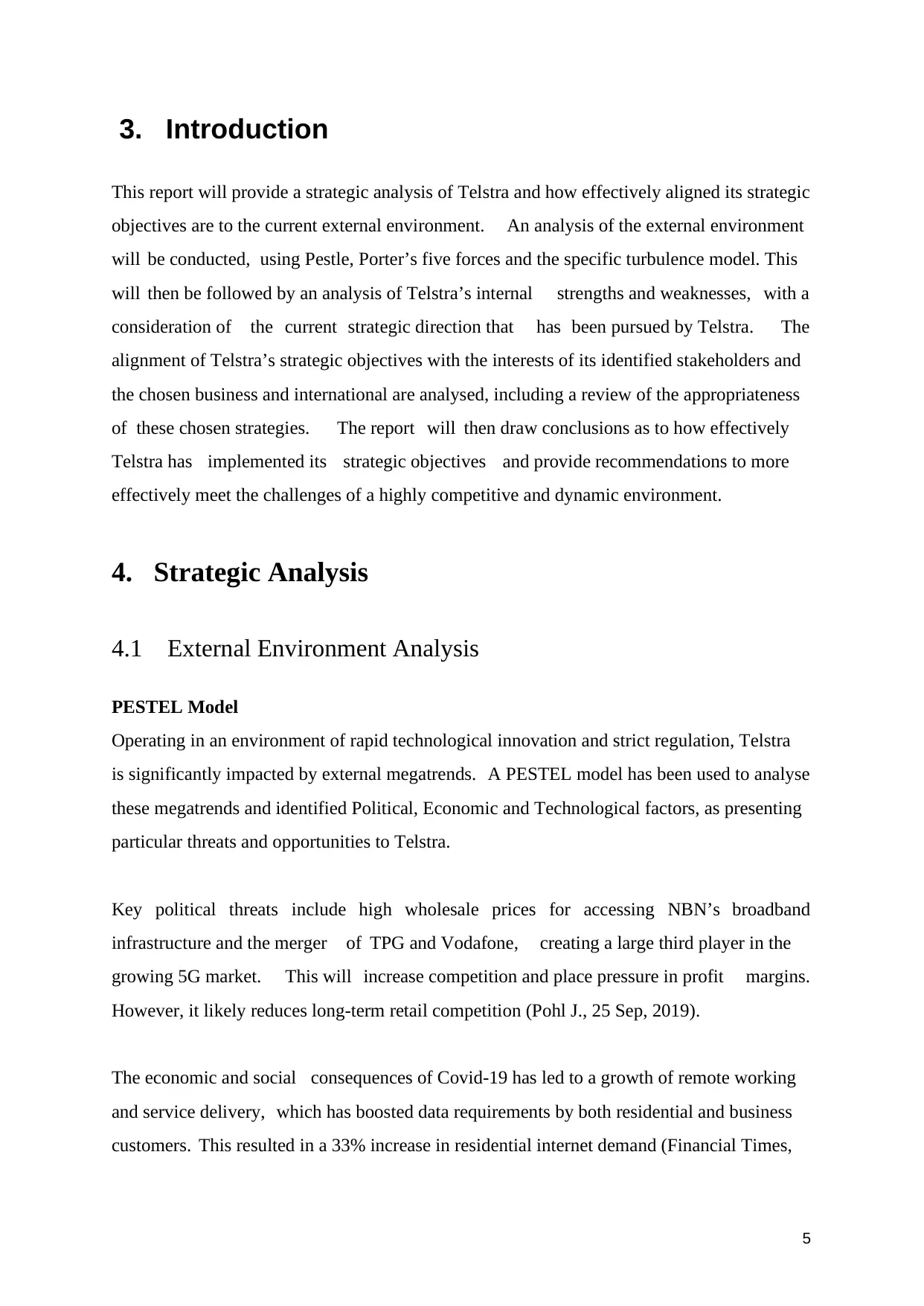
3. Introduction
This report will provide a strategic analysis of Telstra and how effectively aligned its strategic
objectives are to the current external environment. An analysis of the external environment
will be conducted, using Pestle, Porter’s five forces and the specific turbulence model. This
will then be followed by an analysis of Telstra’s internal strengths and weaknesses, with a
consideration of the current strategic direction that has been pursued by Telstra. The
alignment of Telstra’s strategic objectives with the interests of its identified stakeholders and
the chosen business and international are analysed, including a review of the appropriateness
of these chosen strategies. The report will then draw conclusions as to how effectively
Telstra has implemented its strategic objectives and provide recommendations to more
effectively meet the challenges of a highly competitive and dynamic environment.
4. Strategic Analysis
4.1 External Environment Analysis
PESTEL Model
Operating in an environment of rapid technological innovation and strict regulation, Telstra
is significantly impacted by external megatrends. A PESTEL model has been used to analyse
these megatrends and identified Political, Economic and Technological factors, as presenting
particular threats and opportunities to Telstra.
Key political threats include high wholesale prices for accessing NBN’s broadband
infrastructure and the merger of TPG and Vodafone, creating a large third player in the
growing 5G market. This will increase competition and place pressure in profit margins.
However, it likely reduces long-term retail competition (Pohl J., 25 Sep, 2019).
The economic and social consequences of Covid-19 has led to a growth of remote working
and service delivery, which has boosted data requirements by both residential and business
customers. This resulted in a 33% increase in residential internet demand (Financial Times,
5
This report will provide a strategic analysis of Telstra and how effectively aligned its strategic
objectives are to the current external environment. An analysis of the external environment
will be conducted, using Pestle, Porter’s five forces and the specific turbulence model. This
will then be followed by an analysis of Telstra’s internal strengths and weaknesses, with a
consideration of the current strategic direction that has been pursued by Telstra. The
alignment of Telstra’s strategic objectives with the interests of its identified stakeholders and
the chosen business and international are analysed, including a review of the appropriateness
of these chosen strategies. The report will then draw conclusions as to how effectively
Telstra has implemented its strategic objectives and provide recommendations to more
effectively meet the challenges of a highly competitive and dynamic environment.
4. Strategic Analysis
4.1 External Environment Analysis
PESTEL Model
Operating in an environment of rapid technological innovation and strict regulation, Telstra
is significantly impacted by external megatrends. A PESTEL model has been used to analyse
these megatrends and identified Political, Economic and Technological factors, as presenting
particular threats and opportunities to Telstra.
Key political threats include high wholesale prices for accessing NBN’s broadband
infrastructure and the merger of TPG and Vodafone, creating a large third player in the
growing 5G market. This will increase competition and place pressure in profit margins.
However, it likely reduces long-term retail competition (Pohl J., 25 Sep, 2019).
The economic and social consequences of Covid-19 has led to a growth of remote working
and service delivery, which has boosted data requirements by both residential and business
customers. This resulted in a 33% increase in residential internet demand (Financial Times,
5
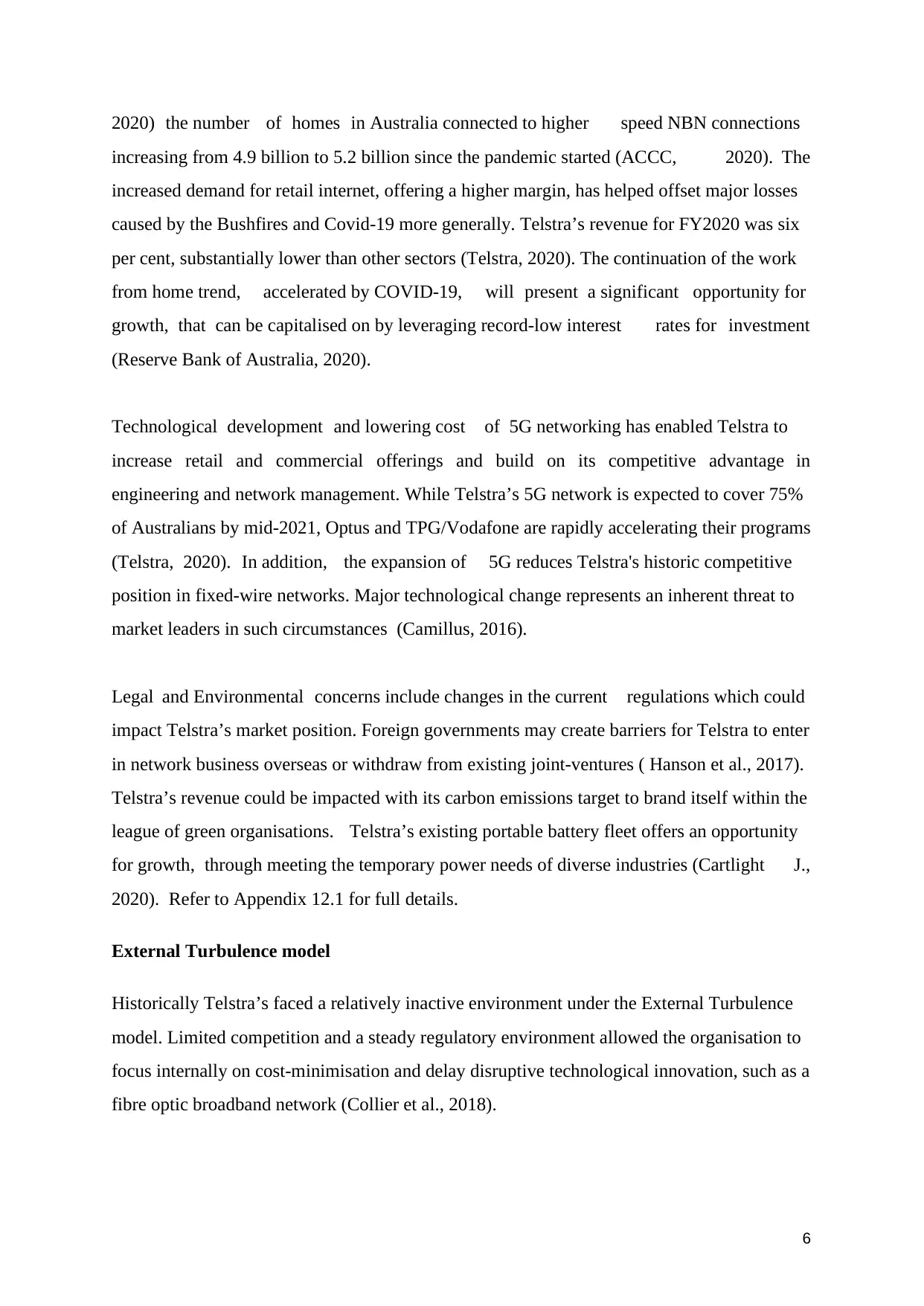
2020) the number of homes in Australia connected to higher speed NBN connections
increasing from 4.9 billion to 5.2 billion since the pandemic started (ACCC, 2020). The
increased demand for retail internet, offering a higher margin, has helped offset major losses
caused by the Bushfires and Covid-19 more generally. Telstra’s revenue for FY2020 was six
per cent, substantially lower than other sectors (Telstra, 2020). The continuation of the work
from home trend, accelerated by COVID-19, will present a significant opportunity for
growth, that can be capitalised on by leveraging record-low interest rates for investment
(Reserve Bank of Australia, 2020).
Technological development and lowering cost of 5G networking has enabled Telstra to
increase retail and commercial offerings and build on its competitive advantage in
engineering and network management. While Telstra’s 5G network is expected to cover 75%
of Australians by mid-2021, Optus and TPG/Vodafone are rapidly accelerating their programs
(Telstra, 2020). In addition, the expansion of 5G reduces Telstra's historic competitive
position in fixed-wire networks. Major technological change represents an inherent threat to
market leaders in such circumstances (Camillus, 2016).
Legal and Environmental concerns include changes in the current regulations which could
impact Telstra’s market position. Foreign governments may create barriers for Telstra to enter
in network business overseas or withdraw from existing joint-ventures ( Hanson et al., 2017).
Telstra’s revenue could be impacted with its carbon emissions target to brand itself within the
league of green organisations. Telstra’s existing portable battery fleet offers an opportunity
for growth, through meeting the temporary power needs of diverse industries (Cartlight J.,
2020). Refer to Appendix 12.1 for full details.
External Turbulence model
Historically Telstra’s faced a relatively inactive environment under the External Turbulence
model. Limited competition and a steady regulatory environment allowed the organisation to
focus internally on cost-minimisation and delay disruptive technological innovation, such as a
fibre optic broadband network (Collier et al., 2018).
6
increasing from 4.9 billion to 5.2 billion since the pandemic started (ACCC, 2020). The
increased demand for retail internet, offering a higher margin, has helped offset major losses
caused by the Bushfires and Covid-19 more generally. Telstra’s revenue for FY2020 was six
per cent, substantially lower than other sectors (Telstra, 2020). The continuation of the work
from home trend, accelerated by COVID-19, will present a significant opportunity for
growth, that can be capitalised on by leveraging record-low interest rates for investment
(Reserve Bank of Australia, 2020).
Technological development and lowering cost of 5G networking has enabled Telstra to
increase retail and commercial offerings and build on its competitive advantage in
engineering and network management. While Telstra’s 5G network is expected to cover 75%
of Australians by mid-2021, Optus and TPG/Vodafone are rapidly accelerating their programs
(Telstra, 2020). In addition, the expansion of 5G reduces Telstra's historic competitive
position in fixed-wire networks. Major technological change represents an inherent threat to
market leaders in such circumstances (Camillus, 2016).
Legal and Environmental concerns include changes in the current regulations which could
impact Telstra’s market position. Foreign governments may create barriers for Telstra to enter
in network business overseas or withdraw from existing joint-ventures ( Hanson et al., 2017).
Telstra’s revenue could be impacted with its carbon emissions target to brand itself within the
league of green organisations. Telstra’s existing portable battery fleet offers an opportunity
for growth, through meeting the temporary power needs of diverse industries (Cartlight J.,
2020). Refer to Appendix 12.1 for full details.
External Turbulence model
Historically Telstra’s faced a relatively inactive environment under the External Turbulence
model. Limited competition and a steady regulatory environment allowed the organisation to
focus internally on cost-minimisation and delay disruptive technological innovation, such as a
fibre optic broadband network (Collier et al., 2018).
6
⊘ This is a preview!⊘
Do you want full access?
Subscribe today to unlock all pages.

Trusted by 1+ million students worldwide
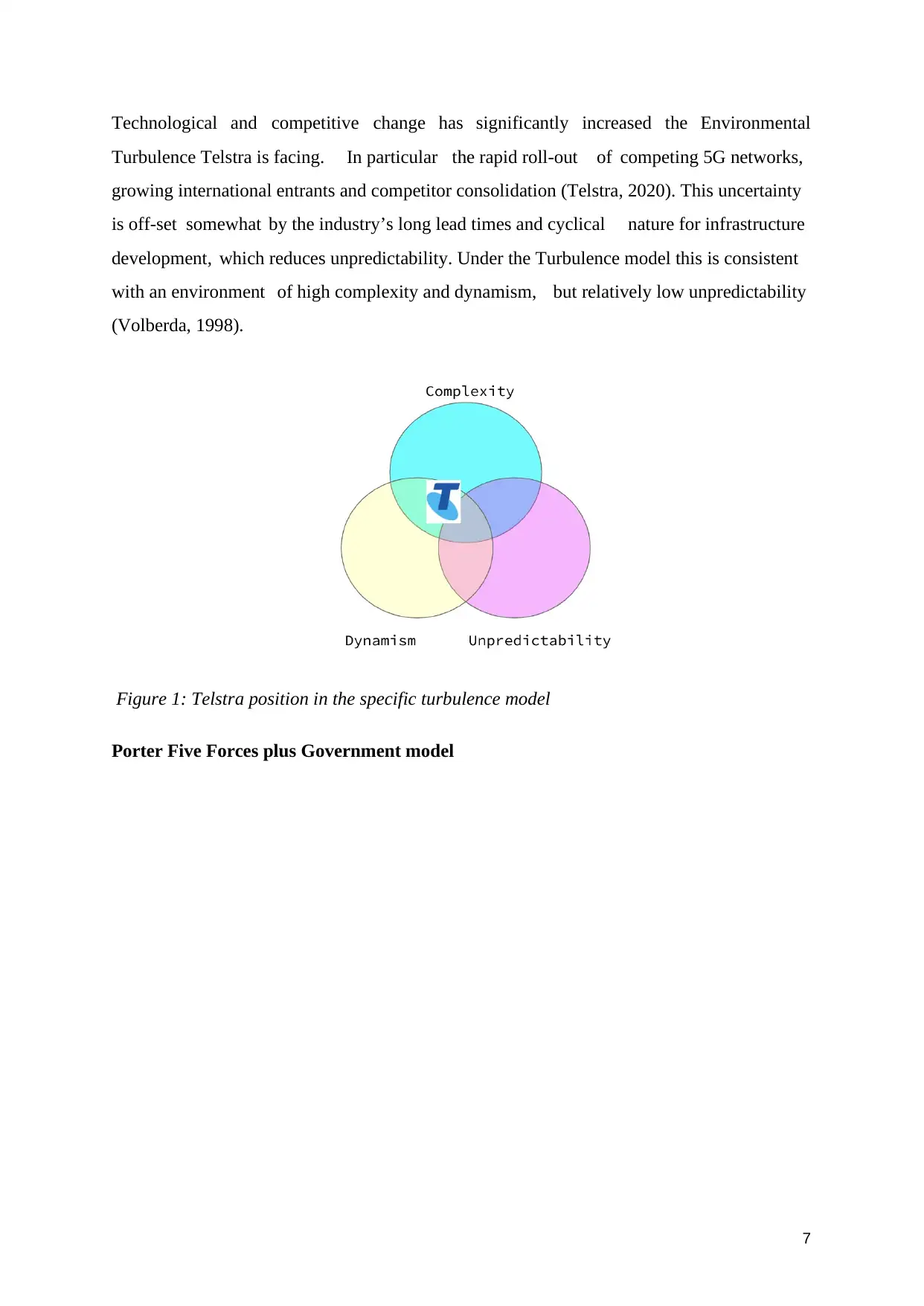
Technological and competitive change has significantly increased the Environmental
Turbulence Telstra is facing. In particular the rapid roll-out of competing 5G networks,
growing international entrants and competitor consolidation (Telstra, 2020). This uncertainty
is off-set somewhat by the industry’s long lead times and cyclical nature for infrastructure
development, which reduces unpredictability. Under the Turbulence model this is consistent
with an environment of high complexity and dynamism, but relatively low unpredictability
(Volberda, 1998).
Figure 1: Telstra position in the specific turbulence model
Porter Five Forces plus Government model
7
Turbulence Telstra is facing. In particular the rapid roll-out of competing 5G networks,
growing international entrants and competitor consolidation (Telstra, 2020). This uncertainty
is off-set somewhat by the industry’s long lead times and cyclical nature for infrastructure
development, which reduces unpredictability. Under the Turbulence model this is consistent
with an environment of high complexity and dynamism, but relatively low unpredictability
(Volberda, 1998).
Figure 1: Telstra position in the specific turbulence model
Porter Five Forces plus Government model
7
Paraphrase This Document
Need a fresh take? Get an instant paraphrase of this document with our AI Paraphraser
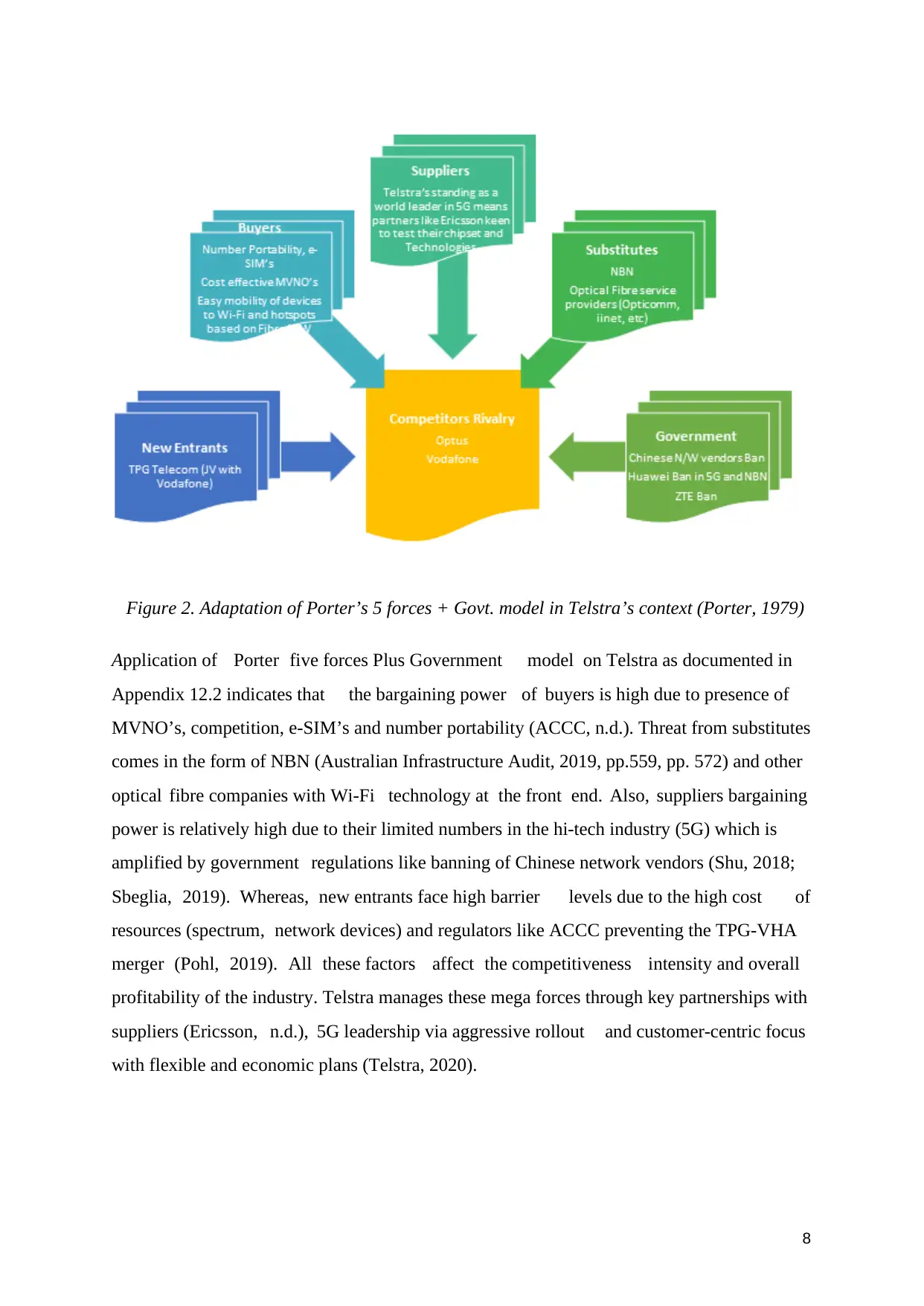
Figure 2. Adaptation of Porter’s 5 forces + Govt. model in Telstra’s context (Porter, 1979)
Application of Porter five forces Plus Government model on Telstra as documented in
Appendix 12.2 indicates that the bargaining power of buyers is high due to presence of
MVNO’s, competition, e-SIM’s and number portability (ACCC, n.d.). Threat from substitutes
comes in the form of NBN (Australian Infrastructure Audit, 2019, pp.559, pp. 572) and other
optical fibre companies with Wi-Fi technology at the front end. Also, suppliers bargaining
power is relatively high due to their limited numbers in the hi-tech industry (5G) which is
amplified by government regulations like banning of Chinese network vendors (Shu, 2018;
Sbeglia, 2019). Whereas, new entrants face high barrier levels due to the high cost of
resources (spectrum, network devices) and regulators like ACCC preventing the TPG-VHA
merger (Pohl, 2019). All these factors affect the competitiveness intensity and overall
profitability of the industry. Telstra manages these mega forces through key partnerships with
suppliers (Ericsson, n.d.), 5G leadership via aggressive rollout and customer-centric focus
with flexible and economic plans (Telstra, 2020).
8
Application of Porter five forces Plus Government model on Telstra as documented in
Appendix 12.2 indicates that the bargaining power of buyers is high due to presence of
MVNO’s, competition, e-SIM’s and number portability (ACCC, n.d.). Threat from substitutes
comes in the form of NBN (Australian Infrastructure Audit, 2019, pp.559, pp. 572) and other
optical fibre companies with Wi-Fi technology at the front end. Also, suppliers bargaining
power is relatively high due to their limited numbers in the hi-tech industry (5G) which is
amplified by government regulations like banning of Chinese network vendors (Shu, 2018;
Sbeglia, 2019). Whereas, new entrants face high barrier levels due to the high cost of
resources (spectrum, network devices) and regulators like ACCC preventing the TPG-VHA
merger (Pohl, 2019). All these factors affect the competitiveness intensity and overall
profitability of the industry. Telstra manages these mega forces through key partnerships with
suppliers (Ericsson, n.d.), 5G leadership via aggressive rollout and customer-centric focus
with flexible and economic plans (Telstra, 2020).
8
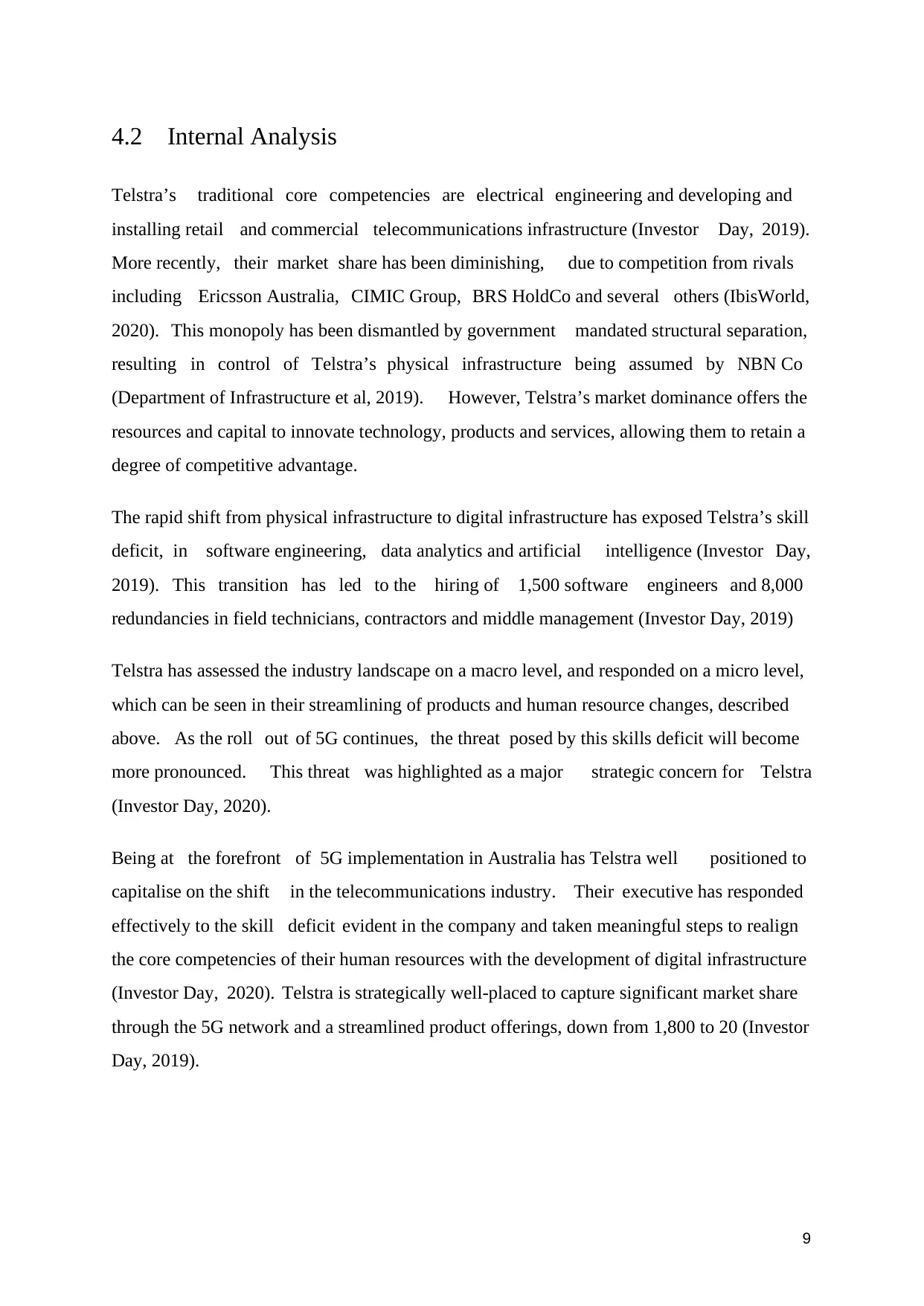
4.2 Internal Analysis
Telstra’s traditional core competencies are electrical engineering and developing and
installing retail and commercial telecommunications infrastructure (Investor Day, 2019).
More recently, their market share has been diminishing, due to competition from rivals
including Ericsson Australia, CIMIC Group, BRS HoldCo and several others (IbisWorld,
2020). This monopoly has been dismantled by government mandated structural separation,
resulting in control of Telstra’s physical infrastructure being assumed by NBN Co
(Department of Infrastructure et al, 2019). However, Telstra’s market dominance offers the
resources and capital to innovate technology, products and services, allowing them to retain a
degree of competitive advantage.
The rapid shift from physical infrastructure to digital infrastructure has exposed Telstra’s skill
deficit, in software engineering, data analytics and artificial intelligence (Investor Day,
2019). This transition has led to the hiring of 1,500 software engineers and 8,000
redundancies in field technicians, contractors and middle management (Investor Day, 2019)
Telstra has assessed the industry landscape on a macro level, and responded on a micro level,
which can be seen in their streamlining of products and human resource changes, described
above. As the roll out of 5G continues, the threat posed by this skills deficit will become
more pronounced. This threat was highlighted as a major strategic concern for Telstra
(Investor Day, 2020).
Being at the forefront of 5G implementation in Australia has Telstra well positioned to
capitalise on the shift in the telecommunications industry. Their executive has responded
effectively to the skill deficit evident in the company and taken meaningful steps to realign
the core competencies of their human resources with the development of digital infrastructure
(Investor Day, 2020). Telstra is strategically well-placed to capture significant market share
through the 5G network and a streamlined product offerings, down from 1,800 to 20 (Investor
Day, 2019).
9
Telstra’s traditional core competencies are electrical engineering and developing and
installing retail and commercial telecommunications infrastructure (Investor Day, 2019).
More recently, their market share has been diminishing, due to competition from rivals
including Ericsson Australia, CIMIC Group, BRS HoldCo and several others (IbisWorld,
2020). This monopoly has been dismantled by government mandated structural separation,
resulting in control of Telstra’s physical infrastructure being assumed by NBN Co
(Department of Infrastructure et al, 2019). However, Telstra’s market dominance offers the
resources and capital to innovate technology, products and services, allowing them to retain a
degree of competitive advantage.
The rapid shift from physical infrastructure to digital infrastructure has exposed Telstra’s skill
deficit, in software engineering, data analytics and artificial intelligence (Investor Day,
2019). This transition has led to the hiring of 1,500 software engineers and 8,000
redundancies in field technicians, contractors and middle management (Investor Day, 2019)
Telstra has assessed the industry landscape on a macro level, and responded on a micro level,
which can be seen in their streamlining of products and human resource changes, described
above. As the roll out of 5G continues, the threat posed by this skills deficit will become
more pronounced. This threat was highlighted as a major strategic concern for Telstra
(Investor Day, 2020).
Being at the forefront of 5G implementation in Australia has Telstra well positioned to
capitalise on the shift in the telecommunications industry. Their executive has responded
effectively to the skill deficit evident in the company and taken meaningful steps to realign
the core competencies of their human resources with the development of digital infrastructure
(Investor Day, 2020). Telstra is strategically well-placed to capture significant market share
through the 5G network and a streamlined product offerings, down from 1,800 to 20 (Investor
Day, 2019).
9
⊘ This is a preview!⊘
Do you want full access?
Subscribe today to unlock all pages.

Trusted by 1+ million students worldwide
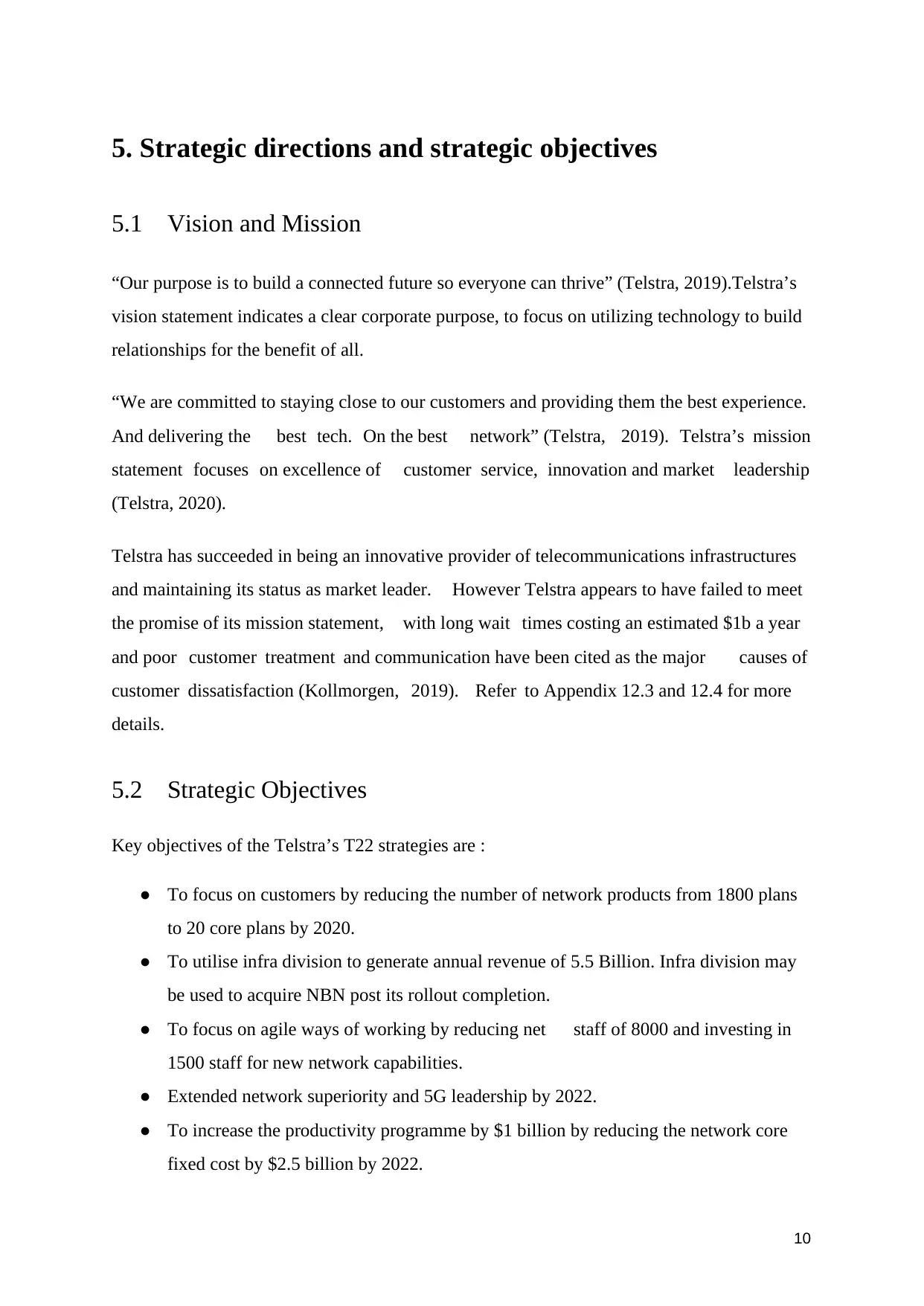
5. Strategic directions and strategic objectives
5.1 Vision and Mission
“Our purpose is to build a connected future so everyone can thrive” (Telstra, 2019).Telstra’s
vision statement indicates a clear corporate purpose, to focus on utilizing technology to build
relationships for the benefit of all.
“We are committed to staying close to our customers and providing them the best experience.
And delivering the best tech. On the best network” (Telstra, 2019). Telstra’s mission
statement focuses on excellence of customer service, innovation and market leadership
(Telstra, 2020).
Telstra has succeeded in being an innovative provider of telecommunications infrastructures
and maintaining its status as market leader. However Telstra appears to have failed to meet
the promise of its mission statement, with long wait times costing an estimated $1b a year
and poor customer treatment and communication have been cited as the major causes of
customer dissatisfaction (Kollmorgen, 2019). Refer to Appendix 12.3 and 12.4 for more
details.
5.2 Strategic Objectives
Key objectives of the Telstra’s T22 strategies are :
● To focus on customers by reducing the number of network products from 1800 plans
to 20 core plans by 2020.
● To utilise infra division to generate annual revenue of 5.5 Billion. Infra division may
be used to acquire NBN post its rollout completion.
● To focus on agile ways of working by reducing net staff of 8000 and investing in
1500 staff for new network capabilities.
● Extended network superiority and 5G leadership by 2022.
● To increase the productivity programme by $1 billion by reducing the network core
fixed cost by $2.5 billion by 2022.
10
5.1 Vision and Mission
“Our purpose is to build a connected future so everyone can thrive” (Telstra, 2019).Telstra’s
vision statement indicates a clear corporate purpose, to focus on utilizing technology to build
relationships for the benefit of all.
“We are committed to staying close to our customers and providing them the best experience.
And delivering the best tech. On the best network” (Telstra, 2019). Telstra’s mission
statement focuses on excellence of customer service, innovation and market leadership
(Telstra, 2020).
Telstra has succeeded in being an innovative provider of telecommunications infrastructures
and maintaining its status as market leader. However Telstra appears to have failed to meet
the promise of its mission statement, with long wait times costing an estimated $1b a year
and poor customer treatment and communication have been cited as the major causes of
customer dissatisfaction (Kollmorgen, 2019). Refer to Appendix 12.3 and 12.4 for more
details.
5.2 Strategic Objectives
Key objectives of the Telstra’s T22 strategies are :
● To focus on customers by reducing the number of network products from 1800 plans
to 20 core plans by 2020.
● To utilise infra division to generate annual revenue of 5.5 Billion. Infra division may
be used to acquire NBN post its rollout completion.
● To focus on agile ways of working by reducing net staff of 8000 and investing in
1500 staff for new network capabilities.
● Extended network superiority and 5G leadership by 2022.
● To increase the productivity programme by $1 billion by reducing the network core
fixed cost by $2.5 billion by 2022.
10
Paraphrase This Document
Need a fresh take? Get an instant paraphrase of this document with our AI Paraphraser
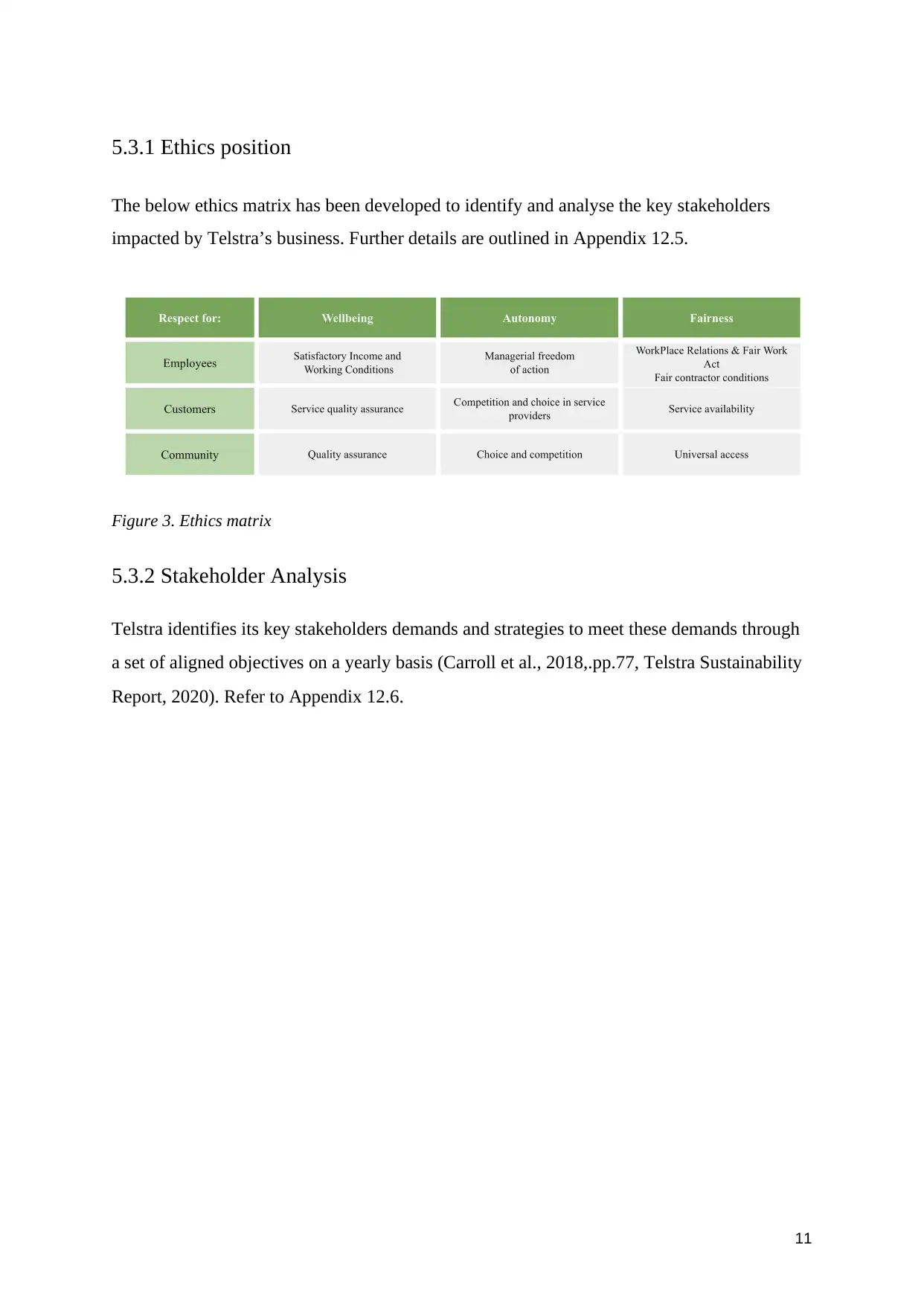
5.3.1 Ethics position
The below ethics matrix has been developed to identify and analyse the key stakeholders
impacted by Telstra’s business. Further details are outlined in Appendix 12.5.
Figure 3. Ethics matrix
5.3.2 Stakeholder Analysis
Telstra identifies its key stakeholders demands and strategies to meet these demands through
a set of aligned objectives on a yearly basis (Carroll et al., 2018,.pp.77, Telstra Sustainability
Report, 2020). Refer to Appendix 12.6.
11
The below ethics matrix has been developed to identify and analyse the key stakeholders
impacted by Telstra’s business. Further details are outlined in Appendix 12.5.
Figure 3. Ethics matrix
5.3.2 Stakeholder Analysis
Telstra identifies its key stakeholders demands and strategies to meet these demands through
a set of aligned objectives on a yearly basis (Carroll et al., 2018,.pp.77, Telstra Sustainability
Report, 2020). Refer to Appendix 12.6.
11
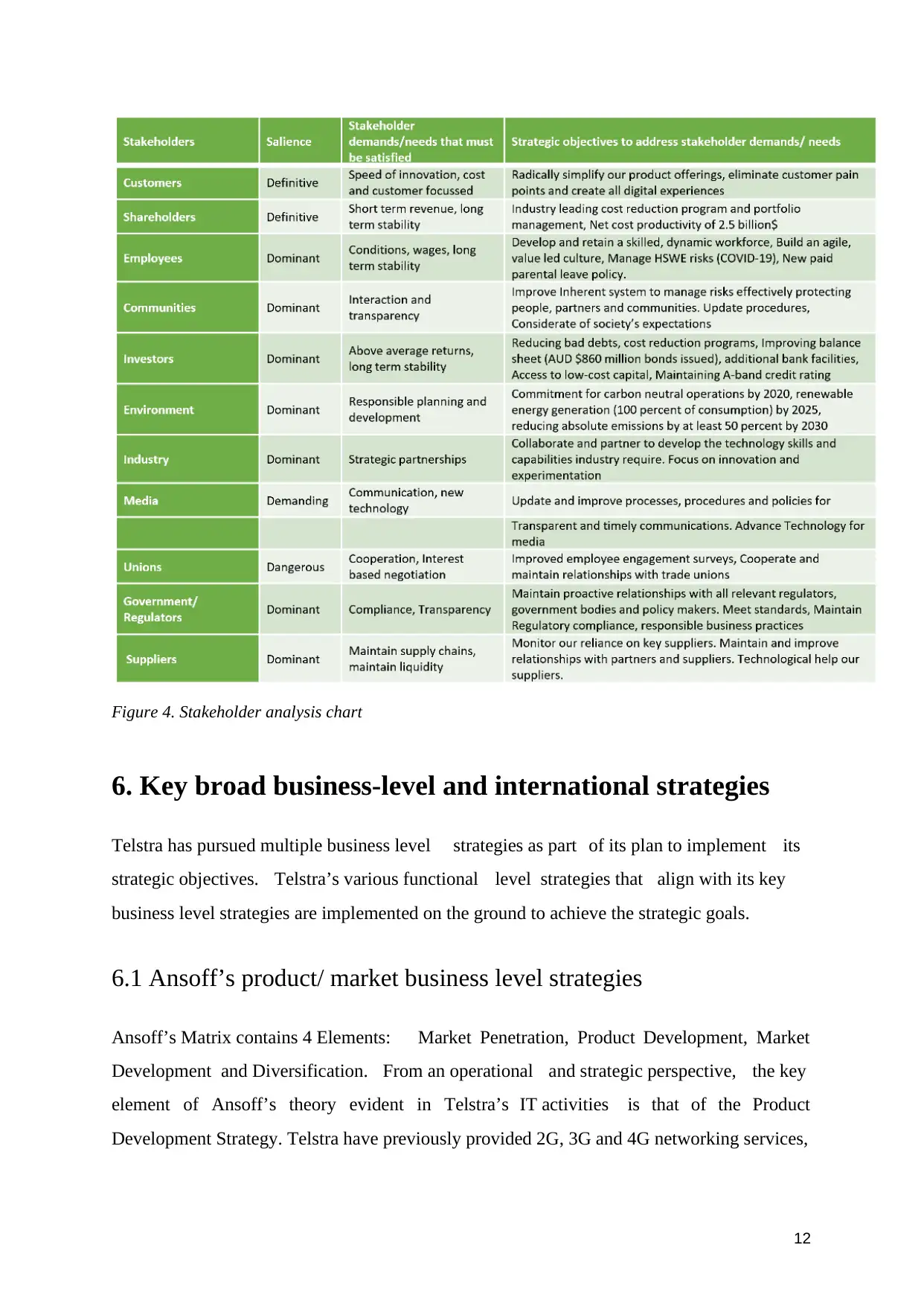
Figure 4. Stakeholder analysis chart
6. Key broad business-level and international strategies
Telstra has pursued multiple business level strategies as part of its plan to implement its
strategic objectives. Telstra’s various functional level strategies that align with its key
business level strategies are implemented on the ground to achieve the strategic goals.
6.1 Ansoff’s product/ market business level strategies
Ansoff’s Matrix contains 4 Elements: Market Penetration, Product Development, Market
Development and Diversification. From an operational and strategic perspective, the key
element of Ansoff’s theory evident in Telstra’s IT activities is that of the Product
Development Strategy. Telstra have previously provided 2G, 3G and 4G networking services,
12
6. Key broad business-level and international strategies
Telstra has pursued multiple business level strategies as part of its plan to implement its
strategic objectives. Telstra’s various functional level strategies that align with its key
business level strategies are implemented on the ground to achieve the strategic goals.
6.1 Ansoff’s product/ market business level strategies
Ansoff’s Matrix contains 4 Elements: Market Penetration, Product Development, Market
Development and Diversification. From an operational and strategic perspective, the key
element of Ansoff’s theory evident in Telstra’s IT activities is that of the Product
Development Strategy. Telstra have previously provided 2G, 3G and 4G networking services,
12
⊘ This is a preview!⊘
Do you want full access?
Subscribe today to unlock all pages.

Trusted by 1+ million students worldwide
1 out of 41
Related Documents
Your All-in-One AI-Powered Toolkit for Academic Success.
+13062052269
info@desklib.com
Available 24*7 on WhatsApp / Email
![[object Object]](/_next/static/media/star-bottom.7253800d.svg)
Unlock your academic potential
Copyright © 2020–2025 A2Z Services. All Rights Reserved. Developed and managed by ZUCOL.




